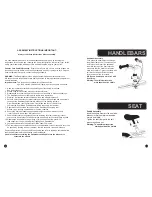
69
a few things to think about:
• ONCE A CRACKS STARTS IT CAN GROW AND
GRoW fast.
Think about the crack as forming
a pathway to failure. This means that any crack
is potentially dangerous and will only become
more dangerous.
simPle RUle 1:
If you find crack, replace the
part.
• CORROSION SPEEDS DAMAGE. Cracks grow
more quickly when they are in a corrosive
environment. Think about the corrosive solution
as further weakening and extending the crack.
simPle RUle 2:
Clean your bike, lubricate your
bike, protect your bike from salt, remove any salt
as soon as you can.
• STAINS AND DISCOLORATION CAN OCCUR
neaR a CRaCk.
Such staining may be a warning
sign that a crack exists.
simPle RUle 3:
Inspect and investigate any
staining to see if it is associated with a crack.
• SIGNIFICANT SCRATCHES, GOUGES, DENTS
oR sCoRinG CReate staRtinG Points
foR CRaCks.
Think about the cut surface as
a focal point for stress (in fact engineers call
such areas "stress risers," areas where the stress
is increased). Perhaps you have seen glass cut?
Recall how the glass was scored and then broke
on the scored line.
simPle RUle 4:
Do not scratch, gouge or score
any surface. If you do, pay frequent attention to
this area or replace the part.
• SOME CRACKS (particularly larger ones)
may make CReakinG noise as yoU Ride.
Think about such a noise as a serious warning
signal. Note that a well-maintained bicycle will
be very quiet and free of creaks and squeaks.
simPle RUle 5:
Investigate and find the
source of any noise. It may not a be a crack, but
whatever is causing the noise should be fixed
before riding.
Содержание Synapse Carbon
Страница 1: ......
Страница 2: ......
Страница 31: ...29 Figure 11 Figure 12 Figure 13 Figure 14 Figure 15 OPEN OPEN OPEN PUSH...
Страница 65: ...63 This page has been left blank intentionally...
Страница 99: ......
Страница 100: ......
Страница 101: ......
Страница 102: ......
















































